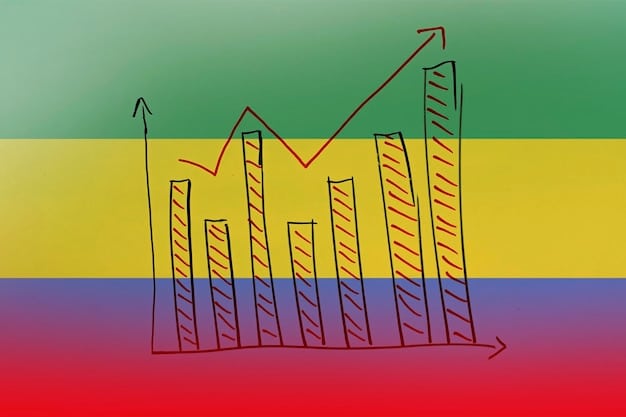Inflation Forecast: How to Protect Your US Dollar in the Next 6 Months

Anúncios
Understanding the expected inflation rate for the US dollar over the next six months is crucial for financial planning; economists’ projections, alongside strategies like investing in inflation-protected securities, diversifying investments, and budgeting wisely, help consumers navigate inflationary pressures and preserve their purchasing power.
Navigating the financial landscape requires a keen understanding of economic indicators, especially when it comes to inflation. What is the Expected Inflation Rate for the US Dollar in the Next 6 Months, and How Can Consumers Prepare? Understanding this and having the right strategies in place can make all the difference in preserving your wealth and maintaining your purchasing power.
Anúncios
Understanding Inflation Expectations for the US Dollar
Inflation, the rate at which the general level of prices for goods and services is rising, erodes the purchasing power of money. Gauging expected inflation rates is essential for consumers and investors alike. Several key factors influence these expectations, and understanding them helps in making informed financial decisions.
Key Factors Influencing Inflation Expectations
Several elements combine to shape inflation expectations. These include economic growth, monetary policy, fiscal policy, and global events. Each of these plays a distinct role in driving or tempering inflationary pressures.
Anúncios
Monitoring these factors provides a comprehensive view of potential inflation trends and allows for more accurate financial planning.
- Economic growth significantly influences inflation. Rapid growth can lead to increased demand, pushing prices higher.
- Monetary policy, especially the actions of the Federal Reserve, plays a crucial role. Interest rate adjustments and quantitative easing can either stimulate or suppress inflation.
- Fiscal policy, including government spending and taxation, can also affect inflation. Increased government spending can boost demand, potentially leading to higher prices.
- Global events, such as supply chain disruptions or geopolitical tensions, can create inflationary pressures by limiting supply and increasing costs.
Inflation expectations can be influenced by various market indicators and surveys. Monitoring these resources provides valuable insight into where inflation might be headed.
Market Indicators and Surveys to Watch
Keeping an eye on market indicators and surveys helps to gauge inflation expectations more accurately. These tools provide a forward-looking perspective on potential inflation trends.
By regularly monitoring these resources, consumers and investors can stay ahead of the curve and adjust their strategies accordingly.
- The Consumer Price Index (CPI) measures the average change over time in the prices paid by urban consumers for a basket of consumer goods and services.
- The Producer Price Index (PPI) measures the average change over time in the selling prices received by domestic producers for their output.
- The University of Michigan Survey of Consumers provides insights into consumer expectations regarding future inflation.
- The Survey of Professional Forecasters offers inflation projections from economists across various sectors.
Understanding the factors influencing inflation expectations and keeping an eye on key market indicators and surveys are crucial for anyone looking to manage their finances effectively in an inflationary environment. This knowledge forms the foundation for strategies that can help preserve and grow wealth.
Current Inflation Projections for the Next 6 Months
Forecasting inflation rates is not an exact science, but economists use various models and data to develop projections. These forecasts can provide a range of possible outcomes, helping consumers understand the potential trajectory of the US dollar’s purchasing power.

Expert Opinions on Near-Term Inflation
Several economic experts and institutions offer their perspectives on the near-term inflation outlook. Their forecasts reflect a range of factors, from current economic conditions to anticipated policy changes.
Comparing these forecasts can provide a balanced view of potential inflation scenarios. It’s essential to consider the methodologies and assumptions behind each prediction to assess its reliability.
- Some economists predict that inflation will remain elevated in the coming months due to persistent supply chain issues and strong consumer demand.
- Others believe that inflation will moderate as the Federal Reserve continues to tighten monetary policy.
- Some forecasts suggest that inflation could fall below the Fed’s target rate if economic growth slows significantly.
Inflation projections vary, reflecting different economic models and assumptions. Understanding these differences is crucial for interpreting forecasts accurately.
Understanding the Range of Possible Outcomes
Given the uncertainty surrounding economic conditions, inflation forecasts typically come with a range of possible outcomes. Understanding this range is essential for effective financial planning.
By considering the best-case and worst-case scenarios, consumers can develop strategies that are resilient to different inflation outcomes. This approach helps to mitigate risk and protect purchasing power.
- The best-case scenario might involve inflation falling rapidly due to successful policy interventions and easing supply chain bottlenecks.
- A moderate scenario could see inflation gradually decline to the Fed’s target rate over the next year.
- The worst-case scenario might involve inflation remaining stubbornly high, requiring more aggressive policy measures and potentially leading to an economic slowdown.
By considering a range of inflation projections and understanding the factors that could influence these outcomes, consumers can make more informed financial decisions. This proactive approach helps to navigate the challenges posed by inflation and safeguard their financial well-being.
How Inflation Impacts Consumers’ Spending Habits
Inflation directly affects consumers’ spending habits by reducing their purchasing power. As prices rise, people need to spend more money to buy the same goods and services, leading to adjustments in their financial behavior.
Changes in Spending Patterns
When inflation rises, consumers often change their spending patterns to manage their budgets. These changes can include cutting back on non-essential items, switching to cheaper alternatives, and delaying major purchases.
Understanding these shifts in spending behavior is crucial for businesses and policymakers. It allows them to anticipate changes in demand and adjust strategies accordingly.
Consumers also need to be mindful of these patterns so they can manage their finances more effectively and avoid unnecessary debt.
- Consumers may reduce spending on discretionary items like dining out, entertainment, and travel.
- They might switch to cheaper brands or generic products to save money on groceries and household goods.
- Major purchases, such as cars and appliances, might be delayed until prices stabilize or financing options become more attractive.
Inflation can lead to increased reliance on credit as consumers try to maintain their standard of living despite rising prices. However, relying too heavily on credit can lead to debt accumulation and financial strain.
The Role of Credit and Debt Management
Managing debt becomes even more critical during inflationary periods. High interest rates and rising prices can make it more difficult to repay debts, potentially leading to financial distress.
Consumers should focus on paying down high-interest debt, such as credit card balances, and avoiding new debt whenever possible. This proactive approach can help to mitigate the negative impacts of inflation on their financial stability.
- Creating a budget and tracking expenses can help consumers identify areas where they can cut back and save money.
- Negotiating lower interest rates with creditors can reduce the cost of borrowing and make debt repayment more manageable.
- Consolidating debt into a lower-interest loan or balance transfer can simplify repayment and save money over time.
Understanding the impact of inflation on spending habits and managing debt effectively are essential for maintaining financial stability during inflationary periods. By making informed choices and implementing sound strategies, consumers can navigate the challenges and protect their financial well-being.
Strategies to Protect Your Finances During Inflation
Protecting your finances during inflation requires a proactive approach and a diversified strategy. Several measures can help to preserve your purchasing power and grow your wealth, even as prices rise.

Investing in Inflation-Protected Securities
Inflation-protected securities, such as Treasury Inflation-Protected Securities (TIPS), are designed to maintain their real value during inflationary periods. These investments offer a hedge against rising prices and can help to preserve your capital.
Investing in TIPS can be a prudent strategy for those concerned about the impact of inflation on their investment portfolio. These securities offer a relatively low-risk way to protect your assets from eroding purchasing power.
It’s important to understand the characteristics and risks of TIPS before investing. Consult with a financial advisor to determine if these securities are suitable for your investment goals and risk tolerance.
- TIPS are government bonds that are indexed to inflation, meaning their principal value increases with inflation.
- They pay a fixed interest rate on the adjusted principal, providing both inflation protection and a steady income stream.
- TIPS can be purchased directly from the government or through brokerage accounts.
Diversifying your investment portfolio is a key strategy for managing risk during inflationary periods. By spreading your investments across different asset classes, you can reduce the impact of inflation on your overall portfolio.
Diversifying Your Investment Portfolio
Diversification involves allocating your investments among various assets, such as stocks, bonds, real estate, and commodities. This approach can help to cushion the impact of inflation and enhance your portfolio’s long-term returns.
A well-diversified portfolio can provide stability and growth potential, even as economic conditions change. It’s essential to rebalance your portfolio periodically to maintain your desired asset allocation.
- Stocks can provide inflation protection because companies can often pass on rising costs to consumers through higher prices.
- Real estate can also serve as an inflation hedge, as property values and rents tend to increase with inflation.
- Commodities, such as gold and silver, are often considered safe-haven assets during inflationary periods.
Protecting your finances during inflation requires a combination of proactive measures and strategic investment decisions. By investing in inflation-protected securities, diversifying your portfolio, and budgeting wisely, you can safeguard your wealth and maintain your purchasing power in an inflationary environment.
Budgeting and Financial Planning in an Inflationary Environment
Effective budgeting and financial planning are crucial during inflationary periods to manage expenses and maintain financial stability. By carefully tracking your spending and making informed financial decisions, you can navigate the challenges of rising prices.
Adjusting Your Budget to Account for Rising Costs
When inflation rises, it’s essential to review and adjust your budget to reflect the increased cost of goods and services. This involves identifying areas where you can cut back on spending and allocating resources more efficiently.
Adjusting your budget proactively can help you stay on track with your financial goals and avoid accumulating debt. It’s a continuous process that requires regular monitoring and adjustments as economic conditions change.
- Start by tracking your expenses to understand where your money is going. This can be done using budgeting apps, spreadsheets, or traditional pen and paper.
- Identify non-essential expenses that you can reduce or eliminate. This might include dining out, entertainment, or subscriptions.
- Look for ways to save money on essential expenses, such as groceries, transportation, and utilities. This could involve switching to cheaper brands, using public transportation, or conserving energy.
Seeking professional financial advice can provide valuable insights and guidance for navigating the complexities of inflation. A financial advisor can help you develop a personalized plan that aligns with your financial goals and risk tolerance.
The Importance of Seeking Professional Advice
A financial advisor can offer expert advice on investment strategies, debt management, and financial planning. They can help you make informed decisions that protect your wealth and enhance your financial well-being.
Working with a financial advisor can be particularly beneficial during inflationary periods, when economic conditions are uncertain and financial decisions are complex. The advisor can help you stay on course and achieve your financial goals.
- A financial advisor can assess your financial situation and develop a personalized plan that addresses your specific needs and goals.
- They can provide guidance on investment strategies that can help you preserve your purchasing power during inflation.
- A financial advisor can help you manage your debt and develop a plan for paying it down effectively.
Budgeting wisely and seeking professional financial advice are essential strategies for navigating the challenges of inflation. By taking these steps, you can protect your finances, maintain financial stability, and achieve your long-term financial goals.
Real Estate and Inflation: What to Expect
Real estate often serves as a hedge against inflation, but understanding how rising prices affect the housing market is essential for both homeowners and potential buyers. Inflation can impact property values, mortgage rates, and rental incomes.
The Impact of Inflation on Property Values
During inflationary periods, property values tend to increase as the cost of building materials and labor rises. This can make real estate an attractive investment for those looking to protect their wealth.
However, rising property values can also make it more difficult for potential buyers to afford a home. This can lead to a slowdown in the housing market and potentially affect the long-term appreciation of property values.
Understanding these dynamics is crucial for making informed decisions about buying or selling real estate during inflationary times.
- Inflation can increase the demand for real estate as investors seek hard assets to protect against currency devaluation.
- Rising property values can lead to higher property taxes, which can increase the cost of homeownership.
- Higher property values can also make it more difficult for first-time homebuyers to enter the market.
Mortgage rates typically rise during inflationary periods as the Federal Reserve tightens monetary policy to combat rising prices. This can increase the cost of borrowing and make it more difficult for potential buyers to qualify for a mortgage.
How Rising Mortgage Rates Affect Home Buyers
Higher mortgage rates can significantly impact the affordability of homes, potentially reducing the number of potential buyers and cooling down the housing market.
Potential homebuyers should carefully consider their budget and financial situation before taking on a mortgage during inflationary periods. It’s essential to shop around for the best rates and terms and to be prepared for the possibility of further rate increases.
- Rising mortgage rates can increase the monthly payments on a home, making it more difficult for buyers to afford the home.
- Higher rates can also reduce the amount of home that buyers can afford, potentially forcing them to settle for a smaller or less desirable property.
- Adjustable-rate mortgages (ARMs) can be more attractive during periods of rising rates, but they also carry the risk of higher payments if rates continue to climb.
Understanding the interplay between real estate and inflation is essential for making informed decisions about buying, selling, or investing in property. By considering the potential impacts of rising prices and mortgage rates, you can navigate the real estate market more effectively and protect your financial interests.
| Key Point | Brief Description |
|---|---|
| 📈 Inflation Factors | Economic growth, monetary & fiscal policies, and global events influence inflation expectations. |
| 📊 Key Indicators | CPI, PPI, and surveys like the University of Michigan’s provide insights into inflation trends. |
| 🛡️ Financial Protection | Invest in TIPS, diversify investments, and adjust budgeting to combat inflationary effects. |
| 🏡 Real Estate Impact | Property values and mortgage rates can rise with inflation, impacting buying power. |
Frequently Asked Questions
▼
The current inflation rate in the US can be found by consulting the Consumer Price Index (CPI) from the Bureau of Labor Statistics (BLS), which is updated monthly.
▼
The Federal Reserve influences inflation primarily through monetary policy, such as adjusting the federal funds rate and conducting open market operations to manage the money supply.
▼
TIPS are government bonds indexed to inflation. Their principal increases with inflation, protecting investors’ purchasing power and providing a fixed interest rate on the adjusted amount.
▼
Diversification reduces inflation’s impact by spreading investments across stocks, bonds, real estate, and commodities, balancing risk and enhancing long-term returns amid economic changes.
▼
To adjust your budget, track expenses, cut non-essential spending, find cheaper alternatives, and save on essentials like groceries, transportation, and utilities to manage rising costs.
Conclusion
Understanding the expected inflation rate for the US dollar and proactively preparing for its potential impacts is essential for maintaining financial stability. By staying informed, diversifying investments, and carefully managing budgets, consumers can navigate inflationary periods with confidence and protect their financial well-being.





